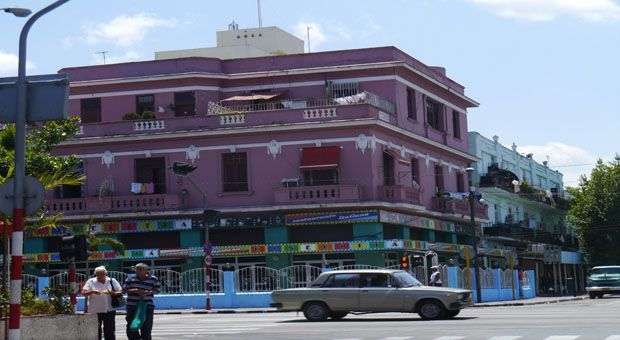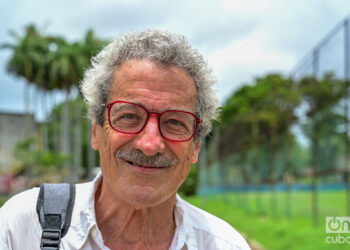The look of historical Vedado begins to move her face. The fact brings concern to professionals from various disciplines including aesthetics. This phenomenon is detrimental to environmental and urban design and, of course, architecture, which always craft and art are wisely combined.
Given the lack of space for the coexistence of so-called extended families-term applied by psychologists to explain the presence of three and four generations of Cubans in the same household, and they don’t have other choice, in many cases, than to build on roofs of old houses.
So the city grows upwards. Each one adds at will a floor on top of the other, without any professional advice or aesthetic grounds.
In search of some considerations about that, OnCuba spoke with the architect and art director Juan García Prieto who has extensive experience in the Film, Television, where he has won several national and international awards, and Theatre.
The writer, designer and researcher is pleased to contribute to the aesthetic education of the new generations through teaching in faculties such as Architecture, Literature, Art Media and Communication Studies at the prestigious International School of Film and TV San Antonio de los Baños (EICTV).
Architecture on the Brink
The greatest vigilance of García Prieto is related to the lack of visibility of architecture in Cuba. This writer is witness to his dream to bring to national television a show where, in an entertaining and educational way the Cuban people receive basic notions of architecture.
However, today issues like architecture and design are usually perceived as synonymous with bad words for Cuban television programming makers.
But the man who was the founding director of the Galician School of Cinema, in Vigo, Spain, doesn’t cease in his efforts to put into practice what has taught in universities and nations like Colombia, Peru, Ecuador, Italy, Spain and the USA.
The first architectural notions that we have come to us from the direct experience in our house, our apartment, which can draw us or not and we can enjoy aesthetically.
Secondly – he said-, we see architecture from afar. You enjoy the city by walking in it, seeing the buildings. The third way is through film, television, audiovisual media.
Thanks to the pictures or the Internet we know today of the Taj Mahal in India, Niagara Falls or the Eiffel Tower. In the last century the magazines played a fundamental role.
Where is the direction of architecture in Cuba? On the threshold of silence. No TV shows, fewer magazines to guide people and where the architect, industrial designer can write specialized articles.
Sloppy everywhere
The so-called self-employed, workers in the tourism and those lucky enough to receive remittances from abroad flaunt their wealth publicly in starting from distorted patterns about architecture and urban design.
Unfortunately, in today’s Cuba, this phenomenon does not happen only at private initiative. Also in the new works that the State builds are used, uncritically, to codes established by the colonial architecture.
So almost clandestine, Juan and this reporter visited one of the private workshops,-known as The Marmolinera of Puentes Grandes, located in the capital’s Plaza de la Revolution municipality-, where they manufacture serially, balustrades, pedestals, load columns, and dissimilar figureheads.
This is the ultimate kitsch fashions in the built environment in Central America and Cuba. Many people find these dolphins, mermaids, frogs, lions and other ornaments placed at the entrance or in the gardens of their homes, beautiful.
The fact responds to the level of aspiration into habits and ways of the people, to a renewal process based on consumption and social groups. As he explains in his college classes aesthetics professor Eduardo Morales, public tastes are parked while criticism has the lead.
The city cannot remain stagnant. Sure it has to change. Indeed, new buildings are projected. In some, you must take into account the historical value, in contrast others simply for the novelty, by modernity.
However, what happens when I think with the right to make the garden as part of historical look of Vedado, and then I add a roof to build a coffee shop or a market, or destroy it putting fences, debris and rubbish bins?
I solved my problem and what about the rest of the city? The city is a living organism that changes and must be respected. Whatever affects urban looks affects me as a citizen. The phenomenon is present throughout the country. From East to West, but the most affected city is Havana.
Today you find the Historic Centre of Camagüey highly conserved. The same is true with Bayamo and Holguin. The work of architect Iran Milian, Director of Heritage in Cienfuegos, is fabulous.
Another commendable example is the work of Dr. Eusebio Leal Spengler, Historian of Havana and Chairman of the National Commission of Monuments.
However, the experience of Leal in Old Havana has not been moved as economic potential to the rest of the city or other historic centers.
The design should flood the lives of Cubans
Many years ago, when I graduated from college and went to the Isla de la Juventud to work I realized that the role of the architect was to design life on any scale, helping people transform life, Garcia explains.
The design must be present at all levels and at all scales. People should have more options than those provided by the architect of the community. As a retired professional I can guide my neighbor if he asks for advice.
In Cuba there are workshops Comprehensive Neighborhood Transformation but … few renowned architects are linked to these workshops. We all know that the salary is not enough. That has been said everywhere, even in the National Assembly of People’s Power.
Now, in these times of economic changes in Cuba, why design professionals and architecture have to stay tied to a state enterprise?
Why don’t they leave us to much more freely exercise the profession? I would like to be hired in a private way even if I had to pay taxes to the Onat (National Tax Administration), through a company.
Things must change. The Guidelines of the Economic and Social Policy should be more specific to the case of architecture and other professions. We will get rich for that. The value in this society is not given by money; it is given by doing it well.
New change times are coming, of autonomy in companies and local governments, in cash and in the economic factor to invest in the town. Hopefully they’ll let me work, transform lives and help design it, concludes the architect.
By: Maya Quiroga










